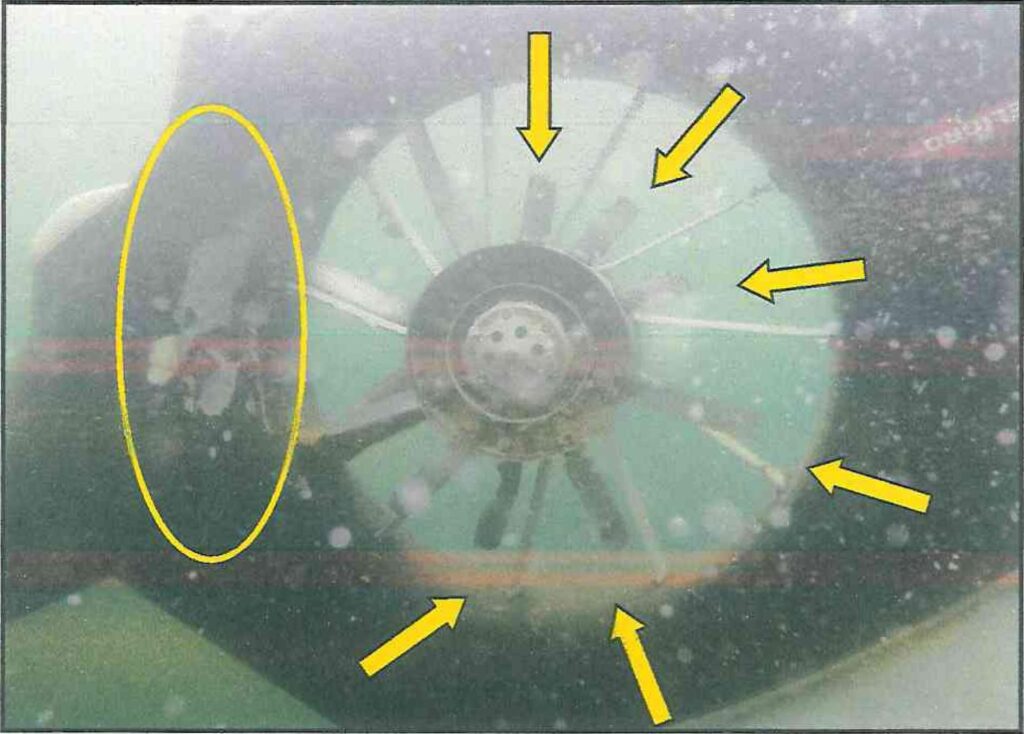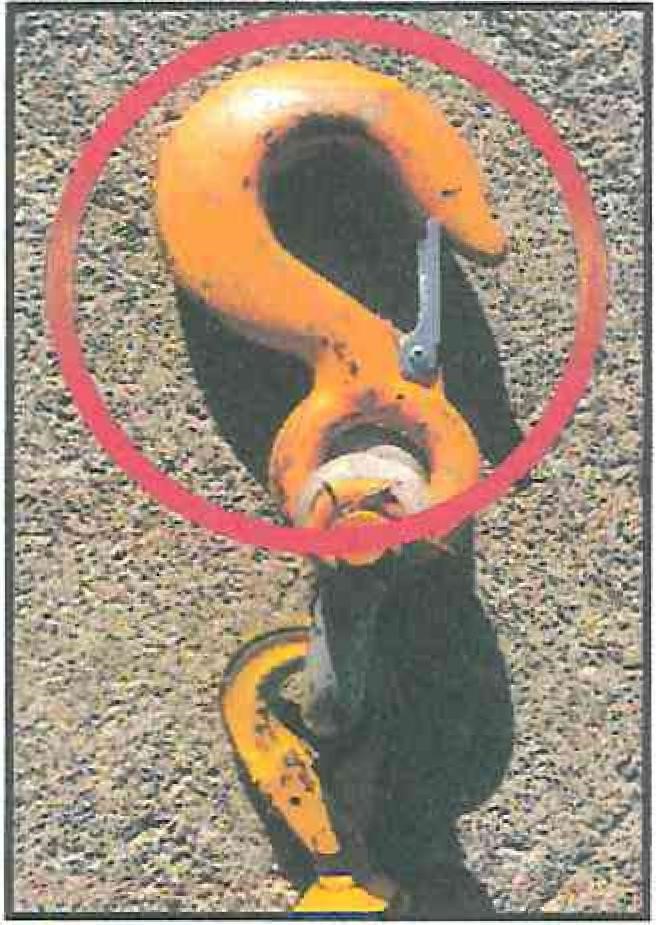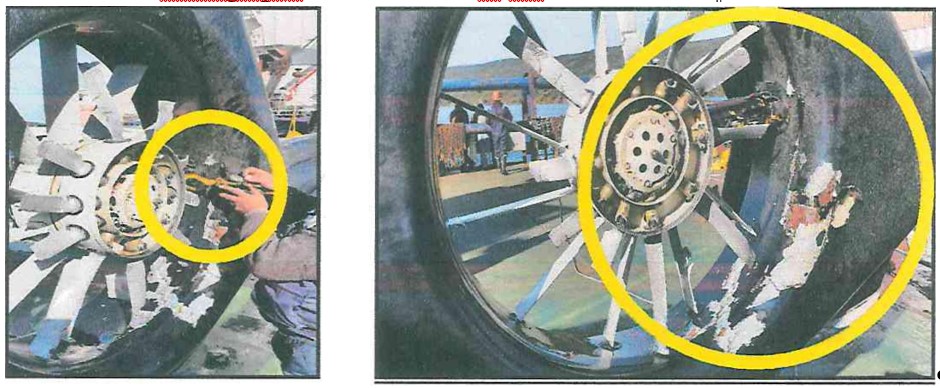HESLO EC135 LOC-I & Water Impact: Hook Confusion after Personnel Change (DAP Helicopteros Airbus EC135T1 CC-CCA)
On 22 December 2018 Airbus EC135T1 CC-CCA of DAP Helicopteros impacted the water of the Beagle Channel off Chile’s Picton Island after a Loss of Control – Inflight (LOC-I) while conducting Helicopter External Sling Load Operations (HESLO) from a ship. The aircraft sank 165 m from shore. The pilot, the sole occupant, was seriously injured but successfully egressed, swam to the remains of a pier and was recovered by boat.

Damaged Fenestron of DAP Helicopteros Airbus EC135T1 CC-CCA Submerged in the Beagle Channel (Credit: DGAC)
The Accident
The accident was investigated by the Dirección General de Aeronáutica Civil (DGAC) Accident Prevention Department. Their safety investigation report was issued in Spanish only. They explain that the pilot (5,215 flying hours of experience, 651 on type) had conducted a number of HESLO cycles to transport loads to the ship. A large extra 25 kg hook was fitted as a safety weight to keep the 6.1 m sling vertical below the helicopter.

Standard, Smaller Hook Attached to Larger Extra Hook (Credit: DGAC)
Briefings were conducted with the ground parties ashore and on the ship and the need for this extra hook was emphasised. A maintenance technician from the helicopter operator had been on board the ship until c17:15 when he travelled ashore to prepare for refuelling. the helicopter.
At 18:04 Local Time, having deposited a further load he pilot commenced manoeuvring away. Upon reaching a speed of 30 knots he heard a noise from the rear of the helicopter. The pilot of CC-CCA identified he no longer had any yaw control through the pedals. He slowed the aircraft to c 30 knots, descended towards 50 ft and commenced a turn to the right. As the helicopter slowed and the aerodynamical side load on the vertical stabiliser reduced the loss of yaw control became aggravated. Ultimately the pilot completely lowered the collective and the aircraft impacted the water, inverted and sank.
The DGAC Safety Investigation
Divers identified that was damage to the right hand side of the fenestron fairing and blades.
However the large extra hook was not found with the helicopter but attached to the last container positioned on the ship.
The pilot stated that while the helicopter was equipped with mirrors he was not able to always readily observe the hook.
Investigators confirmed that the smaller sling load hook could reach the area of damage.

Damaged Fenestron of DAP Helicopteros Airbus EC135T1 CC-CCA After Salvage and Confirmation the Hook Could Contact the Damaged Area (Credit: DGAC)
Examination of GPS data confirmed the aircraft stayed below 69 knots (80 knots is the limit for HESLO).
The helicopter was equipped with an emergency flotation system. It did not deploy. The investigation report does not discuss whether its activation had been commanded by the pilot but had failed or whether the system was not activated.
DGAC Conclusions
Cause:
Loss of directional control of the helicopter during the flight, due to the impact of the hook of the load line against the tail rotor.
Contributory Factors:
Ship’s personnel unhooked the container from the permanent cargo, leaving the load line without its safety weight [the extra hook]
The person in charge of giving the signal of conformity to the pilot did not realize that the line was left without its safety weight.
The pilot did not realize that the permanent charge was not installed in the sling, because the mirror allowed him to partially see the line.
The speed reached by the helicopter would have contributed to the displacement of the load line to the tail rotor.
DGAC don’t comment on the length of line chosen.
Our Safety Observations
The use of a second hook to weight the line created the possibility that the wrong hook would be released. The change in personnel, from the person likely to be familiar with the process, late in the day increased the chances of an error occurring.
Safety Resources
The European Safety Promotion Network Rotorcraft (ESPN-R) has a helicopter safety discussion group on LinkedIn.
Airbus has issued several documents to warn of the risks when operating with external loads including Service Letter No 1727-25-05 of 26 March 2006 and Safety Information Note (SIN) No 3170-S-00 of 3 October 2017.
You may also find these Aerossurance articles of interest:
- Short Sling Stings Speedy Squirrel: Tail Rotor Strike Fire-Fighting in Réunion
- Snagged Sling Line Pulled into Main Rotor During HESLO Shutdown
- Garbage Pilot Becomes Electric Hooker (Helitrans AS350B3 LN-OGA)
- Load Lost Due to Misrigged Under Slung Load Control Cable
- Keep Your Eyes on the Hook! Underslung External Load Safety
- EC120 Underslung Load Accident 26 September 2013 – Report
- Unexpected Load: AS350B3 USL / External Cargo Accident in Norway
- Unexpected Load: B407 USL / External Cargo Accident in PNG
- Fallacy of ‘Training Out’ Error: Japanese AS332L1 Dropped Load
- Inadvertent Entry into IMC During Mountaintop HESLO
- HESLO AS350B2 Dropped Load – Phase Out of Spring-Loaded Keepers for Keeperless Hooks
- Unballasted Sling Stings Speedy Squirrel (HESLO in France)
- Dynamic Rollover During HESLO at Gusty Mountain Site
- Fuel Starvation During Powerline HESLO
- HESLO Baffled Attitude Fuel Starvation Accident
- Running on Fumes: Fatal Canadian Helicopter Accident
- UH-1H Fuel Exhaustion Accident
- Ditching after Blade Strike During HESLO from a Ship
- The Curious Case of the Missing Shear Pin that Didn’t Shear: A Fatal Powerline Stringing Accident
- HESLO Dynamic Rollover in Alaska
- Windscreen Rain Refraction: Mountain Mine Site HESLO CFIT
- When Habits Kill – Canadian MD500 Accident
- Loss of Control During HESLO Construction Task: BEA Highlight Wellbeing / Personal Readiness
- Shocking Accident: Two Workers Electrocuted During HESLO
- NZ Firefighting AS350 Accident: Role Equipment Design Issues
- Night Mountain Rescue Hoist Training Fatal CFIT
- Impatience Comes Before a Fatal Fall During HESLO
- UPDATE 18 March 2023: HESLO AS350 Fatal Accident Positioning with an Unloaded Long Line
- UPDATE 5 August 2023: A Concrete Case of Commercial Pressure: Fatal Swiss HESLO Accident
- UPDATE 6 April 2024: Fatal Fall after HESLO Helicopter Hooks Worker

Recent Comments